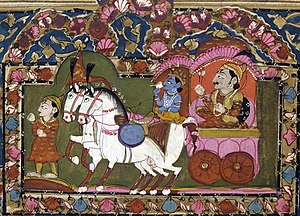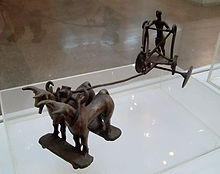Ratha
Ratha (Proto-Indo-Iranian: *Hrátʰas, Vedic Sanskrit: रथ, IAST: rátha; Avestan: raθa) is the Indo-Iranian term for a spoked-wheel chariot.
The term has been used since antiquity for both fast chariots and other wheeled vehicles pulled by animals or humans, in particular the large temple cars or processional carts still used in Indian religious processions to carry images of a deity.
The Indus Valley Civilization sites of Daimabad and Harappa in the Indian subcontinent, there is evidence for the use of terracotta model carts as early as 3500 BC during the Ravi Phase.
[2]The earliest Copper-Bronze Age carts remains that have been found at Sinauli have been dated to 1900 BCE, which were interpreted by some as horse-pulled "chariots", predating the arrival of the horse-centred Indo-Aryans.
Among Rigvedic deities, notably Ushas "Dawn" rides in a chariot, as well as Agni in his function as a messenger between gods and men.
It has been suggested (Sparreboom 1985:87) that the drawings record a story, most probably dating to the early centuries BC, from some center in the area of the Ganges–Yamuna plain into the territory of still neolithic hunting tribes.
[citation needed] Ratha Yatra is a huge Hindu festival associated with Lord Jagannath held at Puri in the Indian state of Odisha during the months of June or July.





